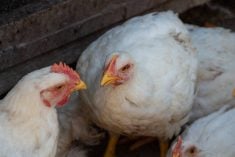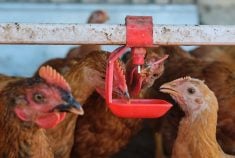Consolidation and restructuring in its meat business, plus improved sales following the 2008 listeriosis scare in cold cuts, has led Maple Leaf Foods back to net profit in its 2009 books.
The Toronto food processing giant on Wednesday reported net earnings of $21.92 million on $1.32 billion in sales in its fourth quarter (Q4) ending Dec. 31, up from a $14.58 million loss on $1.34 billion in the year-earlier period.
Those profits helped put Maple Leaf in the black for fiscal 2009, for which it reported net earnings of $52.15 million on sales of $5.22 billion, up from a net loss of $36.86 million on $5.24 billion in sales in 2008.
Read Also

CFIA adds controls for imports of Spanish feed ingredients after African swine fever outbreak
The Canadian Food Inspection Agency (CFIA) has added Spain to a list of countries subject to feed import controls due to an outbreak of African swine fever in that country.
The Q4 ledger reflects “significantly better performance in our protein business, offset slightly by a softer quarter in the bakery segment,” CEO Michael McCain said in Wednesday’s release.
The company’s results also show the company having weathered the outbreak of listeriosis that started in the summer of 2008 and was tracked back to one of its Toronto meat processing plants. McCain and the company have drawn praise in the business press for their handling of the outbreak.
“Although (2009 Q4) earnings are higher, they compare with a quarter that was materially impacted by the August 2008 product recall, and there still remains significant room to further increase sales and profitability,” the company said in its report.
“Normalized”
Volumes in Maple Leaf’s prepared meats business “continued to trend closer to historical levels,” while lower raw material and packaging costs, a stronger loonie and “normalized supply chain operations” helped widen margins compared to the year-earlier Q4, the company said.
Those margins were compressed in the latter part of Q4, however, as “expected seasonal declines in meat prices did not materialize, with raw material prices rising sharply in December.”
Margins were also pressured in Maple Leaf’s primary processing business due to an increase in live hog market prices, partly offset by better industry processor margins and operating efficiencies in its fresh poultry business.
Maple Leaf in 2009 “substantially completed” the restructuring of its meat (“protein”) operations and focused itself on higher-margin consumer packaged goods, McCain said.
The company’s restructuring, launched in October 2006, included putting its Burlington, Ont. pork plant up for sale, shutting its pork plant in Saskatoon and cancelling plans for a new facility there, with the goal of meeting all of the company’s fresh pork needs through its slaughter and processing plant at Brandon, Man.
Maple Leaf’s agribusiness group, which includes its hog production and animal rendering businesses, improved its Q4 earnings on higher sales volumes of biodiesel (and federal biofuel production credits) from the rendering operations, the company said.
However, the company said its losses in hog production deepened compared to the previous year, due to lower hog prices on average and the stronger loonie.
Sales also dropped in the company’s bakery group, due to foreign exchange translation of its U.K. and U.S. businesses.
Volumes were up in the company’s fresh and frozen North American bakery and pasta businesses, but were offset by lower sales volume in the U.K. bakery operations and the fresh sandwiches business in Canada.














